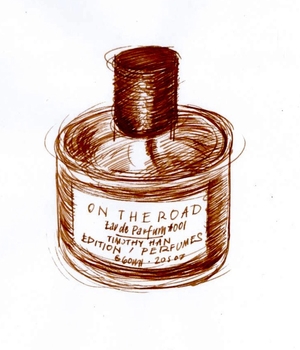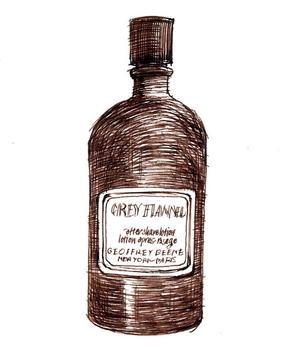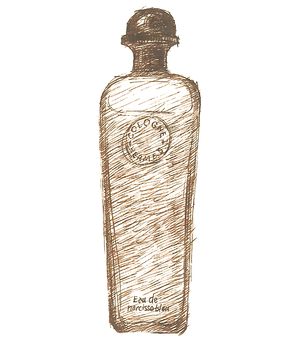Tagged With ‘galbanum’
Edition Perfumes
On the Road
26 November, 2015
 Since it was published in 1957, Jack Kerouac’s amphetamine-fuelled road-and-head-trip of a novel has inspired generations of would-be counter-culturalists to take off into the unknown, but until now, it has never inspired a perfume.
Since it was published in 1957, Jack Kerouac’s amphetamine-fuelled road-and-head-trip of a novel has inspired generations of would-be counter-culturalists to take off into the unknown, but until now, it has never inspired a perfume.
On the Road is only the second scent from East London-based Edition Perfumes, aka perfumer Timothy Han, but it follows in the literary footsteps of his first fragrance, She Came to Stay. Inspired by Simone de Beauvoir’s 1943 novel L’Invitée, She Came to Stay went on to be a best-seller for legendary London fashion boutique Browns.
Taking the plotline of Kerouac’s novel as its starting point, On the Road is one of those rare things in contemporary fragrance: a scent whose story unfolds on the skin – unlike so many recent perfumes, which continue to smell boringly identical from first spritz to final dreary gasp.
As Han describes his perfume, ‘it begins with smoky notes of benzoin and birch reminiscent of the hot asphalt and grittiness of New York City. Punctuated by forays into tobacco-filled bars where a new era in music is being defined by the jazz greats, our journey takes us through the openness of the dusty cornfields of a Mid-Western America and rises to the cedar forests of a Pacific Coast. The restlessness of the journey finally gives way to the optimism left by the fresh green fragrance of galbanum, citrus and bergamot.’
That is quite a lot to squeeze in to a 60ml bottle of perfume, but what we like about On the Road is that it really does develop in the hours after first spraying it on your wrist. Its initial burst of smoke and whisky gradually evolves into a very pleasing, long-lasting woody vetiver. It’s a fine piece of work, and all the more impressive given the quality of the design and packaging – though perhaps that’s less surprising once you learn that Han started his career as an assistant to John Galliano.
Though Han develops and makes his fragrances in his Dalston studio himself, he sees his work very much as a collaborative effort, and for On the Road he’s keen to mention hot young chefs Olia Hercules and Oliver Rowe, Hixter bartender James Randall and model Olivia Inge, without whom its launch, in Han’s words, ‘would have been a no-go’.
But perhaps the biggest shout should go out to the ebullient London artist Cedric Christie, whose photographs from a train trip he took from New Orleans to New York add an authentically On the Road-ish touch to the perfume boxes. Buyers get to choose from five different pictures, adding an extra layer of depth and desirability to the scent. All in all it’s a great launch, and I’m very much looking forward to Timothy Han’s next novel in a bottle.
Slugs and snails and puppy-dogs’ tails
23 April, 2015
A while back I attended a perfume training day with Roja Dove, perfumer extraordinaire in several senses of the word. A small group of us smelled something like a hundred different perfume ingredients, from bergamot to tuberose (the pure extract of which smells far more refined than any of the so-called ‘tuberose’ perfumes I’ve sampled).
Lots of surprises: extract of daffodil smells like hay; galbanum like freshly-podded peas. Fine lavender oil has an oddly sweaty side to it, which I think is one of the things I smell in Guerlain’s legendary Jicky. Roja brings in beaver glands, which gave us the wonderful leathery smell of castoreum (used in Chanel’s Cuir de Russie), and the greasy scrapings from the Ethiopian civet cat, which has the farmyard reek of fresh cow-pats but – in minute quantities – adds a disquieting hint of sex to any perfume in which it (or its synthetic equivalent) is used.
It was a fascinating and really useful day, though it must take daily practise to memorise so many ingredients. What surprised me, though, was the imprecision of perfume terminology. Particularly extracts come from very specific sources: galbanum, for example, derives from the roots of particular species of Iranian fennel (Ferrula gummosa and Ferrula rubricaulis), yet in our training day it was vaguely described as coming from ‘an umbellifer root’. Given that there are over 3,700 individual species in the umbellifer family (now renamed the Apiaceae), that wasn’t much help – cow-parsley is an umbellifer too, but I bet its roots don’t smell like fresh peas.
And as for daffodil smelling like hay, I wanted to know which daffodil: there are between 30 and 70 species of narcissus (the Latin term for daffodil) and hundreds and hundreds of varieties, many of which smell very different from each other.
It struck me as an odd contrast between how incredibly precise perfume chemists have to be, describing specific fragrances down to the molecular level, and yet how imprecise so much perfume terminology seems to be at the same time. If perfumers themselves use such vague descriptions, is it any wonder that we, the perfume-buying public, find the subject so confusing and so hard to understand?
Geoffrey Beene
Grey Flannel
23 February, 2015
 The American fashion designer Geoffrey Beene died of cancer in 2004, but Grey Flannel, the perfume he commissioned from the French fragrance company Roure in the mid-1970s, lives on, and that’s something to be grateful for, as it’s a very appealing scent – even in its current, cheaper incarnation.
The American fashion designer Geoffrey Beene died of cancer in 2004, but Grey Flannel, the perfume he commissioned from the French fragrance company Roure in the mid-1970s, lives on, and that’s something to be grateful for, as it’s a very appealing scent – even in its current, cheaper incarnation.
Created by an otherwise little-known perfumer named André Fromentin, Grey Flannel was launched in 1975 (or 1976, depending on which perfume authority you believe; I’m often surprised how much confusion there seems to be around recent perfume history). Grey flannel was Geoffrey Beene’s signature material, but fortunately that’s not what his first men’s perfume smells of.
In fact Grey Flannel smells of violets, which seems like a weirdly feminine thing to choose for men, yet the clever thing about violets – or to be more precise, about violet leaves – is that as well as smelling sweet they also have a certain woodiness, which makes their scent far less girly than, say, lily-of-the-valley or rose.
Fromentin’s skill was to take this violet-leaf fragrance (which was successfully synthesised in the early 20th century) and mix it with fresh-smelling ingredients such as galbanum (which smells like green pea-pods) and bergamot (one of the most important citrusy components of the classic men’s eau-de-cologne), but also with typical ‘masculine’ woody smells such as oakmoss (actually a kind of lichen), cedar and vetiver.
The result is a deep, rich perfume that combines sweetness and woodiness in equal measure: it’s too sweet for some, but I love it, even though it’s been reformulated in recent years, presumably with cheaper ingredients – though for once at least some of the savings have been passed on to us, the customers, for Grey Flannel is one of the best-value perfumes you can buy.
Hermès
Eau de Narcisse Bleu
10 October, 2014
 Pretty much everyone I know loves Hermès’ deliciously fresh and zingy Eau d’Orange Verte, so when Eau de Narcisse Bleu (literally ‘blue narcissus water’) was launched in 2013 it had a tough act to follow. As I’ve never seen a blue narcissus / daffodil, I think it’s safe to say that this perfume has an element of fantasy about it, and as a smell, too, it’s perhaps rather more complex and a little less instantly accessible than its predecessor. But give it a little time and I think it’ll grow on you.
Pretty much everyone I know loves Hermès’ deliciously fresh and zingy Eau d’Orange Verte, so when Eau de Narcisse Bleu (literally ‘blue narcissus water’) was launched in 2013 it had a tough act to follow. As I’ve never seen a blue narcissus / daffodil, I think it’s safe to say that this perfume has an element of fantasy about it, and as a smell, too, it’s perhaps rather more complex and a little less instantly accessible than its predecessor. But give it a little time and I think it’ll grow on you.
Eau de Narcisse Bleu may not have the euphoric mood-lifting freshness of Eau d’Orange Verte, but it has a gentle softness that, once you’ve smelled it for a while, is extremely appealing in its own right. It does have the faint sweetness of real daffodil flowers (try sticking your nose in one on a sunny day next March and you’ll see what I mean), but what narcissus extract smells of most, rather unexpectedly, is fresh hay. *
Now, I have nothing against smelling of hay, which is a lovely scent in its own right, but what Hermès’ much-mythologised perfumer, Jean-Claude Ellena, has done is blended the smell of hay with a whole raft of subtly complementary fragrances. Most of them are quite ‘green’ – that is, they smell fresh and natural, like grass and leaves, but not especially sweet or flower-like.
To me it has a slight but definite scent of fig-leaves, which for anyone who loves L’Artisan Parfumeur’s wonderful Premier Figuier as much as I do can only be a good thing. Whether this figginess is (excuse the pun) a figment of my imagination I’m not sure, but among the other ingredients that Ellena lists is galbanum, which is extracted from the root of a wild Iranian plant that looks a bit like fennel or cow-parsley, and indeed is distantly related to them.
Galbanum has a marvellously fresh sappy smell like newly-snapped pea-pods, and is one of the most important components of ‘green’ perfumes, but its greenness, here, is tempered by the hay-like sweetness of narcissus, with a hint of earthy bitterness underneath which manages to stop it from smelling at all girly.
If my description makes it sound a bit complicated, don’t be put off, for it’s such a well-blended perfume that there’s nothing discordant about it. In fact if anything it is, perhaps, a little too gentle for its own good, as it’s a ‘quiet’, thoughtful scent that stays close to your skin and doesn’t, on the whole, grab other people’s attention. It’s discreet and refined, in other words, rather than a ‘look-at-me’ perfume, which is perfect if you want to smell good without drawing attention to yourself. Go try it.
* I say ‘narcissus extract’, but one of the irritating things about perfume marketing is how vague – and frankly clueless – most descriptions of perfume ingredients actually are. For as anyone who actually grows the things themselves knows full well, a bright-yellow daffodil like Narcissus ‘February Gold’ smells very different to Narcissus papyraceus, the so-called paperwhite narcissus; the former has a gentle, hay-like scent, while one of the big selling-points of paperwhites is their powerful, almost jasmine-like perfume, the sweetness of which, en masse, can have a touch of the slightly repellent stagnant-water smell that perfumers refer to as ‘indolic’. If only perfume PRs were taught some basic botany.
Postscript – mystery solved, but only by going to the source: in France last week I visited IFF-LMR, the legendary natural raw perfume materials company near Grasse, and what should we get talking about but their narcissus extract, which is derived from the beautiful Narcissus poeticus, fields of which grow wild in the uplands of the Lozère. Did they use other species of daffodil as well? No, came the answer, and it’s their extract that you’re smelling (among many other things) in Eau de Narcisse Bleu.